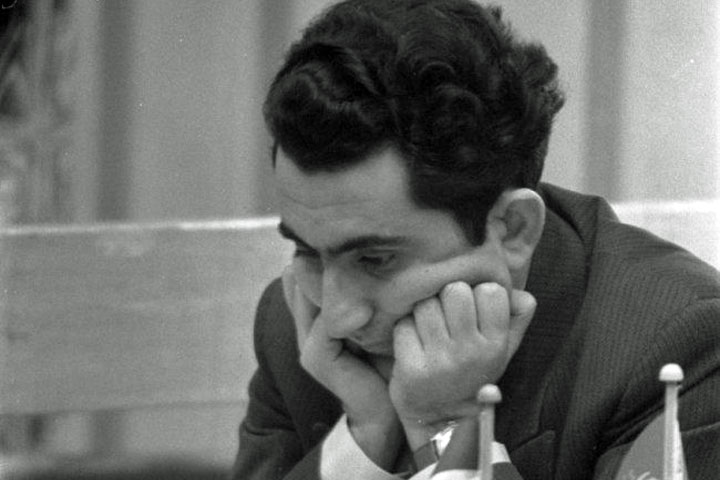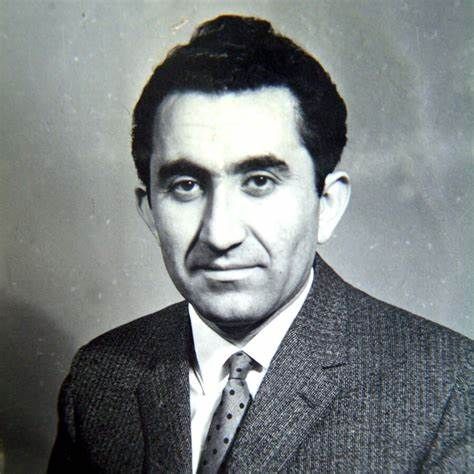


Development refers to improving a chess piece at the beginning of a game, generally by opening the way towards the centre of the board and possibly bringing it out towards the centre of the board. The pieces on the back row begin the game in a very limited state, mostly unable to move or unable to move to many different places. A simplistic guide should be:
Neglecting development might lead to unfortunate situations. We can learn a lot about that by a cautious and defensive giant of chess history.
 Tigran Petrosian
Tigran PetrosianTigran Vartanovich Petrosian was a Soviet-Armenian Grandmaster, nicknamed ‘Iron Tigran’ due to his almost-impenetrable defensive playing style, which emphasized safety above all else. He was a candidate for the World Chess Championship on eight occasions (1953, 1956, 1959, 1962, 1971, 1974, 1977 and 1980). He won the World Championship in 1963 (against Mikhail Botvinnik) to become the ninth World Chess Champion, from 1963 to 1969. He, successfully defended his title in 1966, against Boris Spassky, but lost it in 1969, to Boris Spassky. He is often credited with popularising chess in Armenia.
Petrosian was born to Armenian parents on 17 June 1929, in Tbilisi, Georgia. As a young boy he was an excellent student and enjoyed studying, as did his brother Hmayak and sister Vartoosh. He learned to play chess at the age of 8, though his illiterate father Vartan encouraged him to continue studying, as he thought chess as a career was unlikely to bring his son any success.
Petrosian was orphaned during World War II and was forced to sweep streets to earn a living. In a 1969 interview with Time Magazine, he recalled:
"I started sweeping streets in the middle of the winter and it was horrible. Of course, there were no machines then, so we had to do everything by hand. Some of the older men helped me out. I was a weak boy. And I was ashamed of being a street sweeper – that's natural, I suppose. It wasn't so bad in the early morning when the streets were empty, but when it got light and the crowds came out I really hated it. I got sick and missed a year in school. We had a babushka, a sister of my father, and she really saved me. She gave me bread to eat when I was sick and hungry."
Around this time, his hearing began to deteriorate, a problem that continued to affect him throughout his life.
Petrosian was a conservative, cautious, and highly defensive chess player who was strongly influenced by Aron Nimzowitsch's idea of prophylaxis. He made more effort to prevent his opponent's offensive capabilities than he did to make use of his own, and very rarely went on the offensive unless he felt his position was completely secure. He usually won by playing consistently until an overly aggressive opponent made a mistake, securing victory by capitalising upon this mistake without revealing any weaknesses of his own.
This style of play often led to draws, especially against other players who preferred to counterattack. Nonetheless, his patience and mastery of defence made him extremely difficult to defeat. In fact he was considered to be the hardest player to beat in the history of chess.
To summarize: Petrosian was the defending World Champion or a World Championship Candidate in ten consecutive three-year cycles. He won the Soviet Championship four times (1959, 1961, 1969, and 1975).

Petrosian is responsible for greatly popularizing chess in Armenia. A statue of him stands in the park near the Yerevan Chess House, and his portrait appears on a banknote.
Take a look at the memorable and highly instructive game below [click on the notation or diagrams to get an interactive replayer with engine support]:
As a young junior, Petrosian was playing more aggressively, as the following games I have annotated can prove:
In part two of this Petrosian article I will show you more games from the great master.
In the meantime you might be interested in my latest book:

The Chess Instructor – The Isolated Pawn
by Efstratios Grivas
Every chess player who wishes to improve his level in the difficult subject of chess is obliged to study methodically and understand the existing principles that govern the theory of the opening, middlegame and endgame.
Most chess players focus more on the study of opening theory than other aspects of the game. The reasons are probably clear: opening theory is easier to learn and can provide immediate results, although this is based more on the opponent’s ignorance than our own abilities. Even for a chess trainer, it is easier to teach some variations from this or that opening or a set of simple tactical motifs than to engross himself in the exposition of middlegame and endgame theory.
Yes, middlegame and endgame theory does exist. The great difficulty in approaching it lies in the fact that it does not follow absolute and clear-cut paths, but rather involves deep research in the ideas and logic by which specific types of positions are treated. Moreover, unlike opening theory, the theory of the middlegame and the endgame does not change rapidly based on modern developments and remains almost intact through the years.
In view of the above, any chess player who wishes to follow a chess career or simply become a better player must refrain from the commonplace and assume a different approach. He must develop a good understanding of middlegame and endgame theory, so as to be able in his games to proceed in a proper way after his chosen opening has reached its conclusion.
The purpose of this series is to introduce the reader to advanced training concepts, using the same methods of presentation and instruction that were taught to great players by famous trainers that they have worked with.